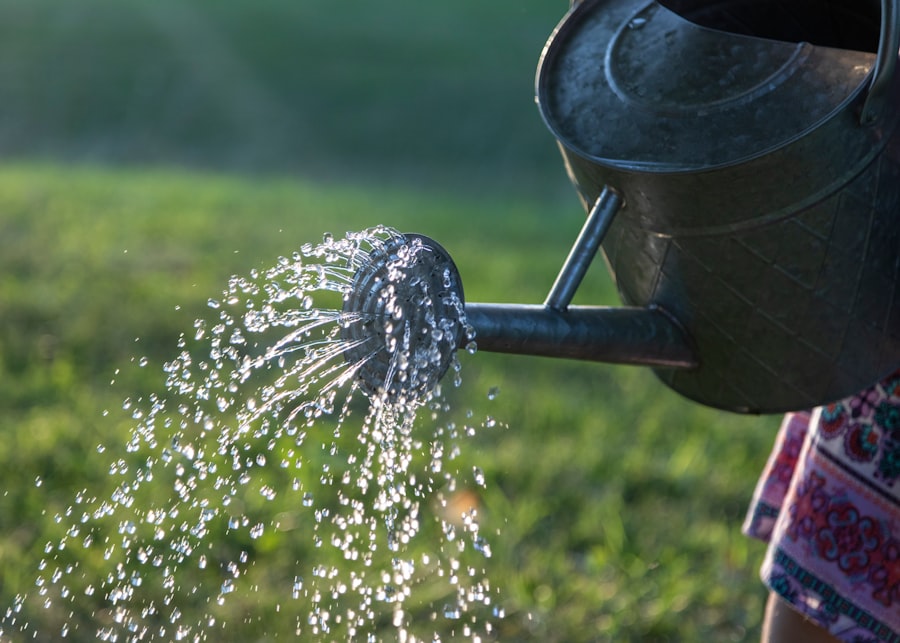Watering cans are indispensable tools in the realm of gardening, serving as the primary means of delivering hydration to plants. Unlike hoses or irrigation systems, watering cans offer a level of control that is crucial for nurturing delicate seedlings and established plants alike. The act of watering is not merely about providing moisture; it is about ensuring that each plant receives the right amount of water at the right time.
This precision is vital for promoting healthy growth, preventing diseases, and encouraging robust root development. A well-designed watering can allows gardeners to target specific areas, ensuring that water penetrates the soil effectively without causing runoff or erosion. Moreover, watering cans foster a deeper connection between gardeners and their plants.
The tactile experience of filling a can, carrying it to the garden, and gently watering each plant can be meditative and fulfilling. This hands-on approach allows gardeners to observe their plants closely, noting changes in growth, health, and even pest activity. In essence, watering cans are not just tools; they are instruments of care that enhance the gardening experience by promoting mindfulness and attentiveness to the needs of plants.
Key Takeaways
- Watering cans play a crucial role in gardening by providing a controlled and efficient way to water plants.
- Traditional watering cans offer a classic and timeless choice for gardeners, with their simple and reliable design.
- Modern watering cans come with innovative features such as adjustable nozzles and ergonomic handles for efficient and comfortable watering.
- Decorative watering cans not only serve a functional purpose but also add style and charm to your garden.
- Long-spout watering cans are ideal for reaching plants in hard-to-reach areas, while short-spout cans provide precision watering for small plants.
Traditional Watering Cans: A Classic Choice for Gardeners
Traditional watering cans have stood the test of time, embodying a design that has been refined over generations. Typically made from galvanized steel or heavy-duty plastic, these cans often feature a simple yet effective design that includes a handle for easy lifting and a spout for controlled pouring. The classic shape allows for a comfortable grip while providing stability when filled with water.
Many gardeners appreciate the nostalgic aesthetic of traditional watering cans, which often evoke memories of childhood gardening experiences or family traditions. The functionality of traditional watering cans is equally noteworthy. They usually come with a removable rose attachment at the spout, which disperses water in a gentle shower, ideal for delicate plants and seedlings.
This feature prevents soil erosion and ensures that water penetrates the soil evenly. Additionally, traditional watering cans are available in various sizes, allowing gardeners to choose one that suits their specific needs—whether it’s a small can for indoor plants or a larger one for outdoor gardens. The durability of these cans means they can withstand the elements, making them a reliable choice for any gardener.
Modern Watering Cans: Innovative Features for Efficient Watering

In recent years, modern watering cans have emerged as innovative alternatives to their traditional counterparts, incorporating features designed to enhance efficiency and ease of use. Many contemporary designs focus on ergonomics, with features such as curved handles and lightweight materials that reduce strain during prolonged use. Some models even include built-in measuring systems that allow gardeners to dispense precise amounts of water, ensuring that plants receive exactly what they need without overwatering.
Additionally, modern watering cans often incorporate advanced materials such as BPA-free plastics or recycled materials, appealing to environmentally conscious gardeners. Some designs feature collapsible structures for easy storage or integrated filters to prevent debris from clogging the spout. These innovations not only improve functionality but also cater to the diverse needs of today’s gardeners, making watering a more enjoyable and efficient task.
Decorative Watering Cans: Adding Style to Your Garden
While functionality is paramount in gardening tools, aesthetics also play a significant role in enhancing the overall garden experience. Decorative watering cans have gained popularity among gardeners who wish to infuse their outdoor spaces with personality and charm. These cans come in an array of colors, patterns, and designs, ranging from whimsical motifs to elegant vintage styles.
A beautifully designed watering can can serve as a focal point in a garden or even as an artistic element on a patio or balcony. Beyond their visual appeal, decorative watering cans can also reflect the gardener’s personality and style. For instance, a brightly colored can with floral patterns may resonate with someone who enjoys vibrant gardens filled with colorful blooms, while a sleek metallic can might appeal to those who prefer a more minimalist aesthetic.
By choosing a decorative watering can that aligns with their tastes, gardeners can create an inviting atmosphere that enhances their gardening experience while also serving a practical purpose.
Long-Spout Watering Cans: Reaching Plants in Hard-to-Reach Areas
Long-spout watering cans are specifically designed to address the challenges posed by hard-to-reach areas in gardens. The extended spout allows gardeners to water plants nestled between dense foliage or in tight spaces without disturbing surrounding plants or soil. This feature is particularly beneficial for container gardens or raised beds where access may be limited.
The precision offered by long-spout designs ensures that water is delivered directly to the roots where it is needed most. In addition to their practical applications, long-spout watering cans can also enhance the overall efficiency of watering routines. By allowing for targeted watering, these cans help conserve water by minimizing waste and runoff.
Gardeners can focus on specific plants that require attention without inadvertently soaking surrounding areas or creating muddy patches. This targeted approach not only promotes healthier plants but also contributes to sustainable gardening practices by using water more judiciously.
Short-Spout Watering Cans: Precision Watering for Small Plants

Short-spout watering cans are ideal for precision watering tasks, particularly when tending to small plants or seedlings that require careful hydration. The shorter spout allows for greater control over water flow, enabling gardeners to direct water exactly where it is needed without oversaturating the soil or damaging fragile roots. This level of precision is crucial during the early stages of plant growth when young plants are particularly vulnerable to overwatering.
These cans are often lightweight and easy to maneuver, making them perfect for indoor gardening or small outdoor spaces where agility is essential. Gardeners can easily navigate around pots on windowsills or small garden beds without fear of spilling water on surrounding surfaces. Additionally, short-spout watering cans are often designed with aesthetics in mind, allowing them to double as decorative elements in indoor spaces while serving their functional purpose.
Indoor Watering Cans: Keeping Houseplants Happy and Healthy
Indoor watering cans are specifically designed to cater to the unique needs of houseplants. These cans typically feature smaller capacities compared to outdoor models, making them easier to handle in confined spaces such as apartments or homes with limited room for gardening tools.
The design often emphasizes ergonomics and ease of use, allowing gardeners to water their houseplants without straining their wrists or arms.
Many indoor watering cans also incorporate features tailored for indoor gardening environments. For instance, some models come equipped with narrow spouts that allow for precise pouring into small pots without spilling water on furniture or floors. Additionally, indoor watering cans may be crafted from materials that complement home decor, such as ceramic or stylish metals, allowing them to blend seamlessly into living spaces while remaining functional tools for plant care.
Self-Watering Watering Cans: Convenience for Busy Gardeners
Self-watering watering cans represent a significant advancement in gardening technology, offering convenience for busy individuals who may struggle to maintain consistent watering schedules. These innovative designs typically feature a reservoir system that allows plants to absorb water gradually over time. By providing a steady supply of moisture, self-watering cans help prevent overwatering and underwatering—two common pitfalls for gardeners with hectic lifestyles.
The convenience offered by self-watering systems is particularly beneficial for those who travel frequently or have demanding work schedules. With these cans, gardeners can fill the reservoir once and trust that their plants will receive adequate hydration even in their absence. This technology not only simplifies plant care but also promotes healthier growth by maintaining consistent moisture levels in the soil.
Ergonomic Watering Cans: Comfortable and Easy to Use
Ergonomics plays a crucial role in the design of modern gardening tools, including watering cans. Ergonomic watering cans are crafted with user comfort in mind, featuring handles that are designed to reduce strain on the hands and wrists during use. Many models incorporate soft grips or contoured shapes that fit comfortably in the hand, allowing gardeners to carry heavier loads without discomfort.
In addition to comfortable handles, ergonomic designs often include balanced weight distribution that makes lifting and pouring easier. This thoughtful engineering minimizes fatigue during extended watering sessions and enhances overall efficiency in garden maintenance tasks. For gardeners who spend significant time tending to their plants, investing in an ergonomic watering can can make a substantial difference in their overall experience.
When selecting a watering can, one of the primary considerations is the material from which it is made—metal or plastic—each offering distinct advantages and disadvantages. Metal watering cans are often favored for their durability and aesthetic appeal; they can withstand harsh weather conditions and resist UV damage over time. Many metal designs also feature beautiful finishes that add character to any garden setting.
On the other hand, plastic watering cans are typically lighter and more affordable than their metal counterparts. They come in various colors and styles, making them versatile options for different gardening aesthetics. However, plastic cans may not be as durable as metal ones and can become brittle over time if exposed to extreme temperatures or sunlight consistently.
Ultimately, the choice between metal and plastic will depend on individual preferences regarding weight, durability, aesthetics, and budget considerations.
Factors to Consider When Choosing a Watering Can for Your Garden
Selecting the right watering can involves considering several factors tailored to individual gardening needs and preferences. First and foremost is capacity; larger gardens may require bigger cans to minimize trips back and forth from the water source, while smaller gardens or indoor plants may benefit from more compact designs that are easier to handle in tight spaces. Another important factor is spout design; gardeners should consider whether they need precision pouring capabilities or if they prefer a more general flow for larger areas.
Additionally, weight plays a significant role—heavier materials may be more durable but could become cumbersome when filled with water. Ergonomics should also be taken into account; choosing a can with comfortable handles will enhance usability during extended periods of gardening. Lastly, aesthetics should not be overlooked; selecting a watering can that complements personal style can enhance the overall gardening experience while adding visual interest to outdoor spaces or indoor plant displays.
By carefully considering these factors—capacity, spout design, weight, ergonomics, and aesthetics—gardeners can choose a watering can that best suits their unique needs and enhances their gardening journey.
If you are looking for tips on how to properly care for your garden, you may want to check out this article on how to maintain a rolling lawn. Having a lush and healthy lawn can greatly enhance the overall look of your garden. Proper watering techniques, such as using the right watering can, can also contribute to the health of your plants. So, make sure to choose the right tools for your gardening needs.
FAQs
What are the different types of watering cans available for gardens?
There are several types of watering cans available for gardens, including traditional metal watering cans, plastic watering cans, long-spout watering cans, and decorative watering cans.
What are the advantages of using a traditional metal watering can?
Traditional metal watering cans are durable, have a classic look, and are often rust-resistant. They are also available in various sizes and can hold a large volume of water.
What are the benefits of using a plastic watering can?
Plastic watering cans are lightweight, affordable, and come in a variety of colors. They are also easy to clean and less likely to rust.
What is a long-spout watering can and when is it useful?
A long-spout watering can has an extended spout, which allows for precise watering of plants, especially those in hard-to-reach areas or hanging baskets.
How can decorative watering cans enhance the garden’s aesthetic appeal?
Decorative watering cans come in various designs, colors, and patterns, adding a decorative touch to the garden while serving their practical purpose.
What factors should be considered when choosing a watering can for a garden?
When choosing a watering can for a garden, factors to consider include the material (metal or plastic), capacity, spout length, handle design, and overall durability. Additionally, consider the weight of the watering can when filled with water.

